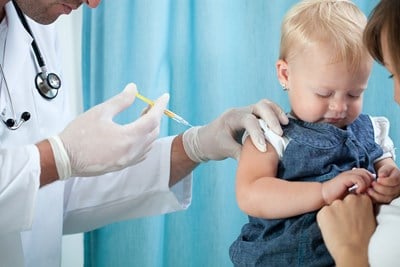Measles is a respiratory virus and extremely contagious, largely because it can survive out of the body for several hours. The transfer usually occurs from mucus or spit, so a cough or sneeze expels the virus into air, where it attaches itself to any nearby host or settles on a table or doorknob. Thankfully, the condition is less common since the advent of vaccinations, particularly once the MMR (measles, mumps, and rubella) shot became available for young children.
Symptoms
It generally takes close to two weeks for symptoms to appear. Since it affects the respiratory system, a cough, runny nose, and sore throat are some of manifestations. The illness also causes white spots in the mouth (known as Koplik’s Spots), high grade fever, sensitivity to light caused by conjunctivitis (inflamed eyes), and sore muscles.
The classic measles symptom, however, is a seven day rash that engulfs the entire body, showing up a few days after the rest of the symptoms. Itchy, red bumps or large blotchy spots start at the head and work their way down. Four days before and after the first appearance of the rash is when the patient is most contagious. The rash is generally the key indicator for a doctor’s diagnosis of measles. If other common symptoms are missing, blood tests may be necessary to positively identify measles as the culprit of the rash, since several other illnesses can result in a similar rash.
Treatment and Prevention
The preferred method of treatment is actually prevention via the MMR vaccine. Since measles is a virus, there is no cure one a person has already become infected. Because of this, symptoms are controlled rather than cured. Acetaminophen is recommended to curb high fevers, and a humidifier can help ease sore throats and coughing. Beyond that, the general procedure for treating colds or the flu are called into play: bed rest, extra fluids, and Vitamin A to boost the immune system. A round of antibiotics may help with additional complication, such as bacterial ear infections.
For unvaccinated people who come into contact with an infectious measles case, immunization within 72 hours may prevent fruition of the illness. Immune serum globulin (a protein antibody) injections may be given in place of the vaccine to people with low functioning immune systems, pregnant women, or extremely young children as a means of diminishing symptoms and potentially fending off the virus all together. Measles typically runs its course after a couple of weeks, leaving its host with an immunity to that particular strain along with potential complications.
Complications
Pneumonia and brain inflammation (encephalitis) can result from the measles. These conditions can be deadly, but modern medicine has reduced the amount of deaths from measles to less than 1%. Bronchitis, ear infections, and diarrhea can show up in tandem with measles, along with blindness and a low blood platelet count (thrombocytopenia). Women may miscarry or go into labor too early if infected during pregnancy.
Risk Factors
Children and people with low functioning immune systems are at the most risk for catching the measles. The first vaccine is given at 12 to 15 months of age, followed by a second round at 4 to 6 years old. A vitamin A deficiency can put the unvaccinated at an even higher risk of contracting it. Those too young to receive the vaccine should be kept away from anyone with measles or symptoms that resemble measles, just to be safe. Luckily, for generally healthy children and adults who develop measles, a full comeback is the most common result.




